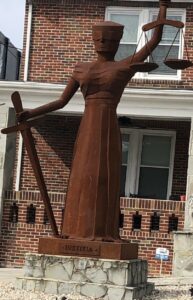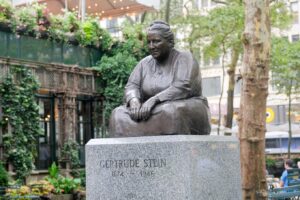
RITA THE ROCK PLANTER
“If you love the forest, the trolls will protect you.” Commissioned by Morton Arboretum for Troll Hunt, dismantled in 2022
Most of the monuments and statues in this blog are created in the likeness of a woman who’s contributed to the feminist movement in a substantial way (see Joan of Arc, Ruth Bader Ginsberg, Flannery O’Connor). On occasion I’ve depicted statues based on legends, folklore or mythology (see Umi, the Curvy Mermaid, Fierce Girl). This is the first time I’m venturing into the whimsical world of trolls; those non-human creatures who live in rocky areas, caves and forests who strive to live in balance with nature and all of earths’ beings. During these divisive times, we could all use a heroine who chooses to root out debris and clear the world from mankind’s mishandling of nature. This time, it’s not just the patriarchy that’s at fault. It’s all of us on the planet and with Earth Day approaching I wanted to remind us that wastefulness, greed and selfishness cannot be tolerated.
Rita the Rock Planter, who resides in Victor, Colorado, is an environmentalist extraordinaire. She’s created by Danish sculptor Thoman Dambo, and is part of his ambitious goal of erecting 16 trolls in 17 continent, with an ultimate total of 1,000 trolls. Rita is made of 100% recycled word products and is a symbolic manifestation of greed. The legend that surrounds Rita tells about a mining town in the 1800’s where Rita lived and roamed in the forest. Frustrated by the miners depletion of the region’s natural resources and angry at herself by her limited efforts to stop them, she went into a cave to take a short nap to regain her strength. Exhausted, she didn’t wake up until hundred year later. What she saw made her weep. Not only was her beautiful land devastated but nobody had reigned in the miners. They took, took and took until there was nothing left to take. Tarnished, ransacked and depleted, the town and its pristine mountain landscape and gently rolling hills was covered with large holes, mostly filled with enormous rocks, debris and trash. Worrying that someone might fall into the crevices and get hurt she franticly removed the rocks and garbage as she filled the holes with dirt. A soft landing for a fellow friend. She toiled long and hard to recapture a once beautiful landscape.
Perhaps you’d like to help her continue the job. There’s much to do. Raise awareness. Honor nature. Become environmental responsible. Repurpose materials. Conserve resources. Fight devastation and depletion of all of the earth’s natural gifts. Plant a garden. Find new innovative ways to live harmoniously. Share. Conserve. Repurpose. Cooperate. Innovate. Think globally.
Rita might not be the coolest troll (Shrek and Fiona come to find). You might not even think she’s the prettiest (Norwegians bestow that award to Huldra, a beauty with the tail of a cow). She’s not even the scariest (ever since I was a kid I trembled in the presence of the troll who lived under the bride in the 3 Billy Goats Gruff). But to me, she’s the Queen of Environmentalism, the altruistic step-sister of Mother Earth. There’s no rest for her as she tirelessly clears our path for a cleaner, friendlier and safer planet.
Brava Rita! Rock on! We’ll enjoy you efforts for as long as long as you continue to toil. Readers, next time you see a piece of trash, pick it up. Whenever you see someone needlessly harvesting resources, call them out on it. Think of Rita as you refill your recycle bin. Stop trolling the internet and get outside. Now!




























